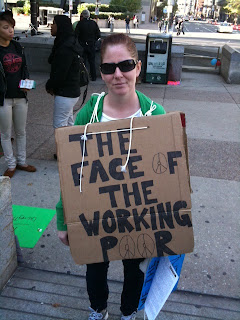This is the second of a three part series called "The Health/Wealth" Gap and features Stacey from Philadelphia.
October 2011: Stacey in Philadelphia
Stacey's mother, Susan, rubbed her child’s cheek. With each stroke she prayed that it would take away the pain or at best, sleep would rescue her baby from the suffering. Susan was recently widowed and with no dental or health insurance, the gentle touch of a mother’s hand was the best she could offer her child. Its the mid 1970's, Stacey is age one, the youngest of the three children her widowed mother had to care for in this working class neighborhood of Philadelphia. Stacey's father died at 38. After almost 20 years of service to the steel mill, the family couldn’t prove that the years left him with the cancer that took his life. They were certain however, that the years of service did leave the family without any health insurance. Stacey's father died 10 months shy of the family being able to collect his pension.
It wasn’t supposed to be like this. When Stacey's parents got married in the early 1970's, they were prepared to fulfill the roles expected of them at the time. Stacey's father had a reliable union job in the steel mill while her mom became a stay-at-home mom of 3 children. They had staked their claim in a home in the Philadelphia neighborhood. They had captured the “American Dream”. At least they thought they had.
Stacey's father's untimely death wasn’t part of the plan. Either was the rheumatoid arthritis that soon set in to her mother's hands. Rheumatoid arthritis, an autoimmune disease, is a condition where the body attacks itself. Like the condition that slowly began to cripple Susan's hands and the rest of her body, life seemed to be doing the same for Stacey's parent's “American Dream.”
As the years went on, Stacey's mother raised the 3 children on the SSI left to them by their father. It was the 1980’s, economic prosperity seemed to loom about the nation. Those were not the memories of Stacy’s childhood. Her mother didn’t qualify for Medicaid because she ‘made too much money’ from the children’s SSI. It was only because of the goodwill of a neighborhood doctor that her mother received free medical oversight. However, kindness and goodwill from one caring doctor didn’t pay for expensive procedures, equipment and medications.
As Stacey grew up, she was determined to break the cycle of poverty she witnessed as a child. Like many Americans, she believed that with hard work she could pull out of poverty. Education was the way to go. She received her LPN and eventually her associate’s degree in nursing (RN). Her first patient was her mother. By this point Susan was considered clinically disabled and qualified for Medicaid. With each changing administration, policy and budget change however, Stacey fought to keep her mother insured. As unpaid bills and cancellation notices came in, Stacey fought. Susan died at the age of 63, 2 years shy of being eligible for Medicare.
Please return next week for Part II of "Stacey's Story".
*names have been changed to protect the identity of the subjects.

No comments:
Post a Comment